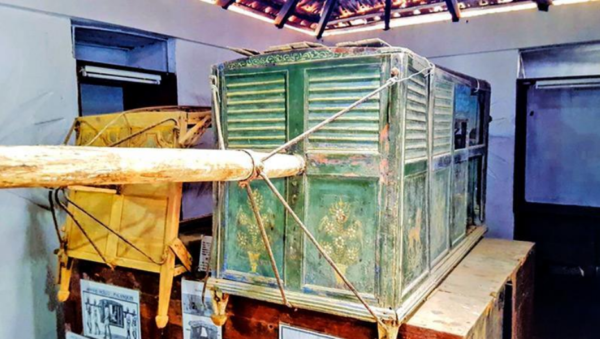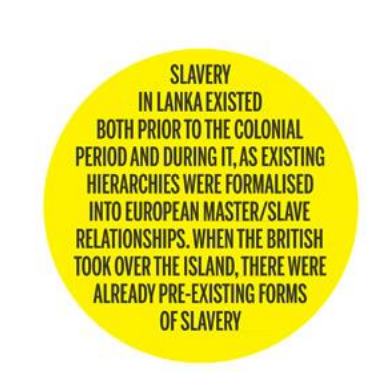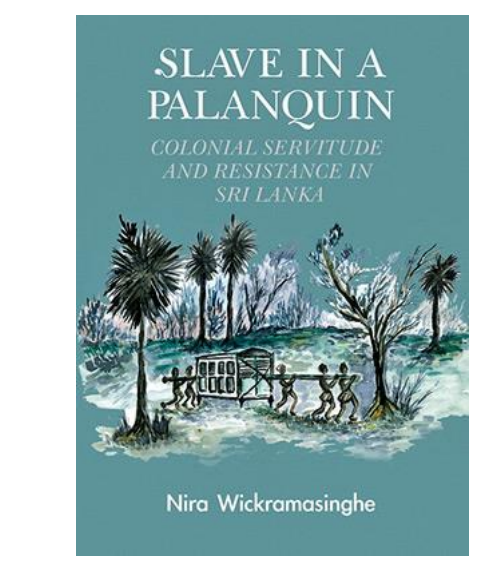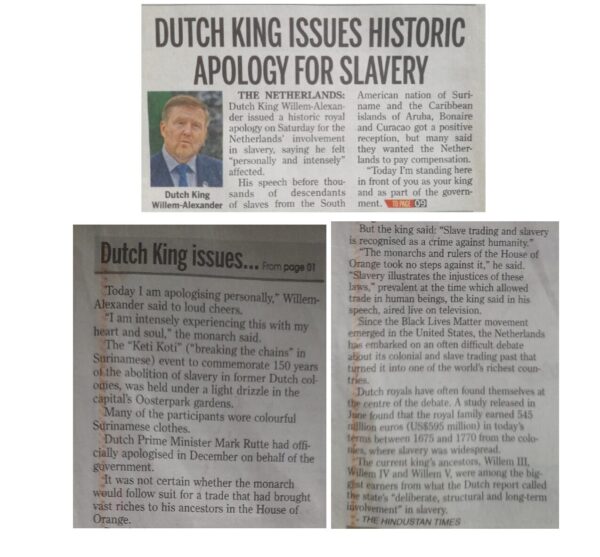The forgotten history of slavery in Sri Lanka – by Tamara Fernando Jesus – College Cambridge
5 September, 2021
Source: sundayobserver

The names Vijayabhahu, Dutugamunu and S.W.R.D. Bandaranaike are likely more familiar to the student of Sri Lankan history than Kedoe, Selestina and Cander Wayreven. Who were these three, and why are their life histories not better known? For one thing, all of them were slaves.

The 23-year-old Kedoe was brutally executed for the murder of a Dutch official named Barent van der Swann and his wife in 1723 (as punishment, Kedoe was quartered and drawn up outside the walls of the Pettah), Selestina was tried in court for killing her new-born baby (the child may have resulted from rape by her master) in Colombo in 1820 and Wayreven was flogged eighteen lashes for travelling in the palanquin of his owner in Jaffna in 1819.
In the early 19th century, over 25,000 people were listed as slaves in Ceylon. But we hardly ever discuss their stories or circumstances when we talk about Sri Lankan history. In an innovative, daring new account, Nira Wickramasinghe’s new book, Slave in a Palanquin. Colonial Servitude and Resistance in Sri Lanka (first published in 2020 by Columbia University Press and now made available in Sri Lanka by Tambapanni Academic Publishers) offers a corrective to these ‘Big Men’ narratives by focusing on the life histories of these enslaved men and women.
Wickramasinghe, a historian of modern Sri Lanka and professor of Modern South Asian Studies at Leiden University is well known for her previous volumes including Dressing the Colonised Body (2003), Metallic Modern (2014) and Sri Lanka in the Modern Age (2014). In this new work, she uses Dutch and British legal archives, police documents, petitions and other documents to recover the “whispers” and “silences” which give us glimpses of the lives of the enslaved and their resistance to power, both European and of local elites.
Master-slave relationships

Slavery in Lanka existed both prior to the colonial period and during it, as existing hierarchies were formalised into European master/slave relationships. When the British took over the island, there were already pre-existing forms of slavery. Kandyan slavery was delineated in the Niti Nighanduwa or treatise of law and slave families were clearly marked out in the Galpata vihara inscriptions (12-13th C).
Slavery also existed in the Jaffna peninsula and in the Portuguese and Dutch controlled maritime provinces. Slavery was practised through the Anuradhapura and Polonnaruwa periods in conjunction with Buddhist temples, royal households and guilds.
Slave in a Palanquin narrates the story of Lanka’s Southern and Northern Maritime Provinces in the era of global abolition. Practically speaking, how does a historian begin to approach the history of slavery? The early nineteenth century saw the formal abolition of slavery in Great Britain (until then, the largest slave-trading power in the world) and its colonies. This process was slow and unsteady as it continued across the world.
In Sri Lanka, abolition was not completed until 1844, when refences to slaves cease in the archives. But documentary evidence before this point is highly revealing. In 1801, for instance, all slaveholders were required to register their slaves. As a result, the historian has access to several large, hefty volumes at the National Archives in the UK known as the ‘Slave Registers’ of Ceylon.
Broken down by geographical region, between 1818 and 1832, these documents provide detailed lists of names and ages for slaves and their children kept by each household, giving us a highly detailed picture of ownership. Colombo in the 1820s, for instance, had a slave population of 348 slave women and 284 slave men.
If Sri Lankans remember slavery at all, they associate it with Africans, the community known as kaffir (Kapiri in Sinhala and Kapili in Tamil, from the Arabic or non-believer). To be black was to be a slave. These ideas are often gross oversimplifications or patent untruths. In the first place, Africans served in a variety of positions that were not slave labour, including in militaries for the Kandyan Kings and the Portuguese Army, which employed up to 400 Africans. They continued to serve as free men in the Third and Fourth Ceylon Regimens.
Old narratives
Popular history, however, continues to recycle old narratives. Consider the oft-cited story of a mass revolt by black slaves in the region of slave island. The name Slave Island, which was used by 1723, referred, in fact, to slaves brought by the VOC from the Indonesian Archipelago. And yet, these links to Southeast Asia are often forgotten. Most accounts describing the kaffir uprising draw on R.L. Brohier’s 1984 account, but Wickramasinghe found no evidence of the event actually taking place. Instead, in a masterful act of detective work involving Dutch legal archives, she finds that the event which did take place was a murder committed by slaves from the East Indies. How a group of enslaved young men and women from the East Indies become remembered as black or African in historical memory is one of the books’ central preoccupations.
Europeans living in Lanka in the Dutch and British colonial periods had large slave retinues, especially as domestic household slaves. Dutch women had retinues of slave girls: “Their chief finery consists in these female attendants, and their splendour is estimated by the number of them which they can afford to keep.”
Similarity, Anglo-Indian wills often mentioned “slave boys” or “slave girls.” But owning slaves was hardly exclusive to Europeans. One eighteenth-century address written by the slaveholding inhabitants of Colombo lists 107 Dutch and Burgher slave owners, as well as a further 38 Tamil Vellales, 17 slave-owners of fisher caste, 24 of washer caste, 20 cinnamon peelers, 30 Malabars and 29 Moors. Listings of slaveholders from the Southern Provinces included Muslim/Moor, Sinhalese and Burgher owners. One Don Francisco Dias Abeywickreme Bandanaraike from Matara, for instance, had 18 slaves and their children in his household. This is a history in which many are complicit, and one that does not obey neat
racial or ethnic distinctions.
The most serious challenge of the book is to histories of the North, where the number of enslaved persons was greatest. In Northern Sri Lanka, the history of caste servitude blends with European legal categories. Based on the Thesawalamai, or Jaffna’s customary law, the Dutch legally designated Chiandos, Coviyar, Nalavarr and Pallar as slave castes. Kutimai (service) and Atimai (bonded) castes thus become, in Dutch and British legal parlance, slaves.The Thesawalamai made explicit reference to transfer of property in slaves, who could be bought, sold, inherited and set free. Slave women are dealt with in a section on cows and sheep. These formal designations affected where and how people could work, move, live, dress, worship and marry.
Harsh punishments
The slave from whose life Wickramasinghe takes her title, for instance, was a Coviyar slave named Cander Wayreven owned by Mapana Mudaliyar of Jaffna. One day on a routine an errand for his master, Wayreven claimed that he fell sick and was “induced to get into the palanquin.” This action—entering the palanquin reserved for high-class Tamils—so deeply violated the social and cultural order that Wayreven was harshly punished. The eighteen scars of the whip on Wayrevan’s back show “the complicity of certain colonial officials with the local dominant groups”, in this case, Vellala Tamils, in enforcing the social order.
The question remains, if hundreds upon hundreds of people in Lanka were slaves, both in the Tamil North and Southern Maritime Provinces, how did we forget this history so completely? For one thing, many formerly enslaved people wanted to erase these histories: colonial Ceylon was a world of hardening identities and being ‘tainted’ with slavery had consequences. Despite this, as with life anywhere, the descendants of slaves worked, married, converted, had children, and went about their lives. As a result, many slaves ‘disappeared’ into well-known communities, including Sinhalese, Tamil, Burgher and Malay. For evidence, consider reports of slave marriages preserved in the archives of the Dutch Reformed Church. These registers give us names such as April Dias of Bengal, Helena Macassar, Augustus Ferdinando, Scipio Janz of Bengal. Slaves, we can see from this list,
often took the names of their masters or their port of origin/departure (Makassar). A woman from the Indonesian island of Timor, therefore, might equally well have a Dutch surname as someone from Delft. A man captured in Arakan and re-sold in Bengal might be known as ‘Fernando.’ So much for pure identities.
On islands such as Sri Lanka, situated between historical and geographic crossroads, identities are often muddied and mixed. Despite this, “Deep roots and purity are crucial in islanders’ sense of belonging,” Wickramasinghe explains, continuing, “accepting the reality of slave ancestry in our midst is akin to accepting that all races are mixed and impure.”
Lineages
Consider the Burghers, who have a neat and uncomplicated story of (often Dutch) European descent. How pure were these lineages, after all? After the fall of Jaffna and Colombo, 200 Dutchmen were reported to have married women of Indo-Portuguese origin. Many Burghers had mixed slave heritage: nineteenth century commentators observed that “the children of emancipated slaves intermarried into descendants of Portuguese who have married native women” and these individuals became an “accreditation to the Burgher.”
Tell someone who identifies as Burgher today that they might have East Asian roots, and your recrimination is likely to be swift and sure. Alternatively, ask a Malay if they have slave, rather than military or royal heritage, and the dismissal will be immediate. Suggest that the Sinhalese might also hail from Java, Surat or Bengal and you will likely cause serious offence. “This book is as much about the present as the past,” Wickramasinghe writes, explaining how “The slave hovers around today like an absent present murmuring what must not be said aloud: that all histories are complex and that claims of origin, purity and innocence of communities belong to the realm of myth.” This is a deeply scholarly and researched book but written in a style that can be read and enjoyed by a broad readership.
Dutch king issuing a historic apology for slavery.








